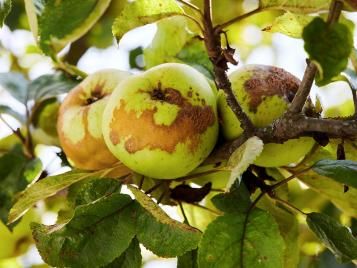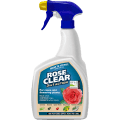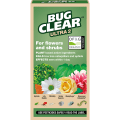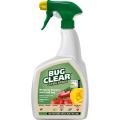

Scab
What is apple and pear scab?
Apple scab attacks apples causing dark, ‘scabby’ marks on the fruit and leaves. It is caused by the fungus Venturia inaequalis. Pear scab is very similar and is caused by Venturia pyrina.
Scab can also occur on ornamental species such as crab apples, Pyracantha, Cotoneaster and Sorbus. The disease tends to be more common during damp seasons and where the branches of the tree or shrub are crowded.
How to identify scab?
From spring onwards greenish-grey scab marks begin to appear on the leaves. Twigs may appear scarred or, in the case of older twigs, blistered.
Blackish-brown scabby spots develop on the fruits.

Scab symptoms and damage
The spots or blotches on the leaves darken as they age. Leaves turn yellow and badly affected leaves fall early. The leaf stalks may also show signs of infection.
As the fruits grow, they may be small and misshapen while a serious scab attack causes splits and cracks, which are prone to other rotting diseases. The fruits cannot be stored when they are damaged in this way.
Light attacks just make the skin of the fruit look unsightly, but the fruit can still be eaten. Infections on young twigs can provide an entry site for other diseases, such as apple canker.
Scab treatment and control
How do you treat scab? Try these suggestions.
- As soon as affected leaves or fruits fall, rake them up and dispose of them to reduce the presence of disease.
- Prune out young stems infected with scab to restrict and control infection.
- High potash plant feeds may help to strengthen the leaves and reduce the risk of the disease taking hold.
- There are no fungicides approved for control of scab diseases on edible plants, but if the ornamental plant or non-edible crab apple (Malus) or pear (Pyrus) tree is also infested with bugs such as aphids, spray with a combined insecticide and fungicide. To protect bees and pollinating insects do not apply to plants when in flower. Do not use where bees are actively foraging. Do not apply when flowering weeds are present.
How to prevent apple scab?
How do you stop apple and pear scab? It’s a good excuse to tidy up the branches of your apple and pear trees and perhaps do some plant shopping.
- Prune the tree to create an open canopy with few branches crowding the middle of the tree, because good airflow helps to reduce infection.
- Some Pyracantha cultivars also show some resistance to Pyracantha scab including: ‘Orange Charmer’, ‘Shawnee’ and ‘Golden Charmer’.
- When you buy a new apple or pear tree, choose a variety which shows resistance to scab infection. Here are some examples: Apples: ‘Discovery’, ‘Lane’s Prince Albert’ or ‘Sunset’. Pears: ‘Jargonelle’ or ‘Catillac’.













